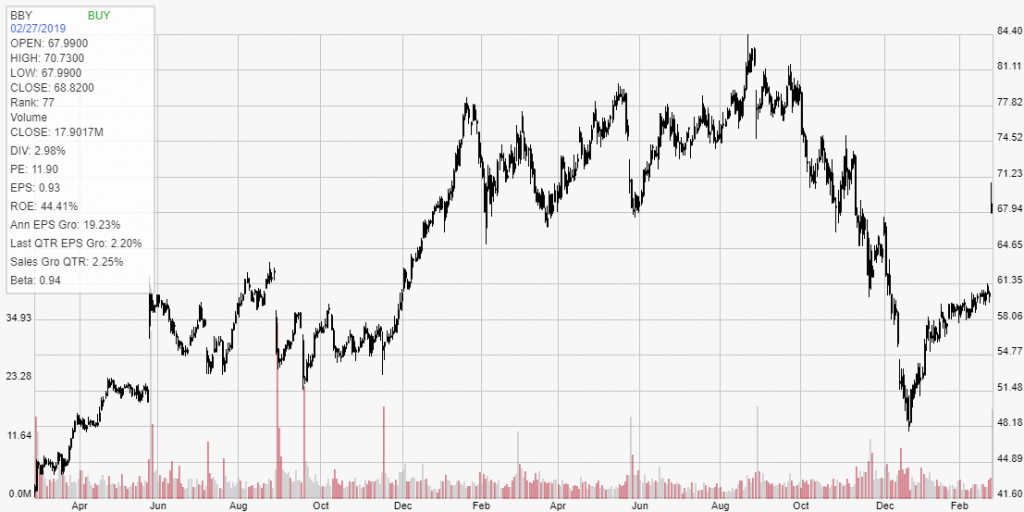Best Buy Co. Inc. (BBY) reported Q4 earnings on Wednesday, further demonstrating its stability in the era of Amazon.com Inc. (AMZN) dominance. The brick-and-mortar electronics retailer easily surpassed Wall Street expectations on the top and bottom lines thanks to a series of initiatives under CEO Hubert Joly.
While most consumers still choose to purchase their electronics online, Best Buy seems to have carved out a niche spot among electronics consumers that has played very well in its favor. A variety of factors are responsible for Best Buy’s latest earnings success, and exploring each one will help investors understand where the legacy retailer is heading.
Here’s a closer look at Best Buy’s recent financials – and the three reasons why the firm’s strong performance should continue throughout the year…
The Numbers
The retailer beat analyst expectations, raking in earnings per share (EPS) of $2.69 for the October-December period. That beat the average estimate of $2.57 per share by 4.7% and marked a nearly 38% increase from $1.95 per share in the year-ago period. Due to overall weaker retail sales in the quarter, analysts anticipated a decline in revenue, which fell by 3.6% to $14.8 billion. However, that still beat Wall Street’s expected $14.7 billion by 0.7%.
Despite in-store sales remaining its bread and butter, the company also posted strong growth in online sales amid increasing competition from Amazon. Best Buy earned $2.96 billion in online revenue in Q4, marking a 9.3% increase year-over-year.
Best Buy’s most widely observed metric is comparable store sales, which measures revenue growth of individual locations over separate periods. Sales at locations open for at least one calendar year climbed 3%, topping the 2% estimated by Wall Street. With that, the company has now reported eight straight quarters of same-store sales growth.
How Investors Reacted
The better-than-expected numbers galvanized investors, who pushed BBY stock up more than 14% from $60.31 to $68.82. That was the highest settlement since Nov. 8 when shares closed at $73.32. With Wednesday’s close, BBY has gained 30% year-to-date from $52.96 to $68.82.
The Bigger Picture
Similar to Walmart Inc. (WMT), which also beat earnings expectations last week, Best Buy has continued to fend off pressure from online retailers by investing heavily in the in-store experience. CEO Hubert Joly, who’s been on board since 2012, pours millions into making retail locations a prime destination for shoppers by improving in-store tech support and creating an attractive physical hub for vendors like Apple Inc. (AAPL) and Samsung Electronics Co. Ltd. (SSNLF).
Joly commented on these aspects of the business during his earnings call, saying that “now is the time to play offense” as Amazon’s shadow grows larger. He also noted how his company’s growth largely comes down to how “customers are noticing the improved experience in stores” as well as their increasing interaction “across all channels,” including online.
But three primary factors come into play when considering Best Buy’s tremendous same-store sales growth over the last eight quarters, the first of which is its embrace of the smart-home device market.
Best Buy has made big pushes into selling more smart-home devices, which are now in 25% of all U.S. households with Internet access. While the company didn’t report specific in-store sales numbers for smart-home devices, Joly said that the size of the Internet-of-Things market – which smart-home devices are an integral component of – remains squarely in Best Buy’s crosshairs as the market is “forecasted to triple by 2025.”
The second factor is the surprising popularity of Fortnite, the video-game phenomenon that offered an unexpected boost to the company’s console, PC, and accessories sales last year. Fortnite user growth has exploded, with the 200 million reported players in November 2018 up 60% from the 125 million reported in June 2018. In an analyst call on Wednesday, Best Buy CFO Corie Barry commented on the way Fortnite “lifted all boats” last quarter, which “genuinely was something that we didn’t see in front of us.” While Joly admitted the Fortnite fever might not last forever, Best Buy seems well positioned to similarly adjust to any new gaming fad in order to capitalize on it accordingly.
And the third factor that elevated Best Buy’s financials is the initiative to sell more toys in the wake of Toys “R” Us shuttering all U.S. stores last year, which left the toy retailer’s more than $10 billion in sales ostensibly up for grabs by competitors. Although it’s always sold more tech-centric toys like drones and remote control cars, Best Buy made a move last fall to increase its selection of new toys by 90%. This likely served as another way to enhance Best Buy’s in-store experience, as parents showed their kids aisle after aisle of new toys to add to the holiday gift list.
Looking Ahead
While many thought the retail apocalypse would devour its business, Best Buy remains the gold standard for fighting the wave of e-commerce brought on by Amazon. Best Buy’s heavy investment in the in-store experience has both increased earnings over the long term and baffled analysts who consistently underestimate the stock, even while the retailer typically keeps expectations modest so it can easily surpass Wall Street estimates. That being said, investors should embrace the company’s remarkable record, which is set to continue thanks to the firm’s own acknowledgment of Wall Street’s lack of faith.
